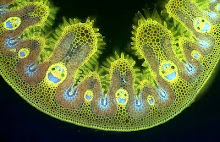Thomas Fairchild (1667-1729) was a nurseryman from Hoxton who is credited with producing the world's first deliberate man-made hybrid plant, when in 1717 he crossed a carnation (Dianthis caryophyllus) with sweet William (D. barbatus) to produce a sterile hybrid with intermediate characteristics. He presented a pressed specimen to the Royal Society and you can see an image of what I assume is the same herbarium specimen here.
Being a devout church-goer and believer in divine creation, Fairchild was perturbed by what he had done, which carried a whiff of blasphemy about it, and perhaps to atone left a bequest to his parish church (St.Leonards in Hackney Road) for an annual sermon on the 'wonderful works of God' which is still delivered annually, at Whitsun, to the Worshipful Company of Gardeners, decked out in their ceremonial gowns, although the venue is now St.Giles, Cripplegate. You can read more about Fairchild here , where there is also a photograph of his gravestone.
Fairchild's experiment was a landmark in plant science, ushering in an era of controlled hybridisation between plant species that has resulted in many of the garden plants that we now grow - and also many important crops. 'Mule', incidentally, as a term for a sterile interspecific hybrid, still persists in animal breeding circles. When I was a child my grandmother kept a goldfinch mule - a purported hybrid between a goldfinch and a canary that was supposed to sing better than either parent.
I've long been intrigued by Fairchild's mule and have often wondered whether one of the parents was indeed a carnation or perhaps might have been a garden pink D.plumarius, which was a popular plant in Fairchild's day, easier to grow, much appreciated for its carnation scent and often referred to in old gardening books and in popular parlance as a 'carnation'. Fairchild almost certainly grew pinks and it's hard to believe that he would not have tried making hybrids with those - especially as they bloom at the same time as sweet Williams.
Anyway, here's my attempt at producing a modern-day equivalent of Fairchild's mule, raised by crossing a garden pink Dianthus plumarius with sweet william D. barbatus, with the former as the female parent. Like Fairchild's mule it turned out to be sterile but was easy enough to propagate from cuttings. I tried to backcross it to both parents but couldn't produce any seed from either of those crosses.... presumably because the hybrid's pollen was sterile.
My mule was very tough little plant with wiry stems - very reminiscent of the herbarium specimen mentioned above and of published descriptions of the original hybrid. It was incredibly floriferous, with every hybrid I raised having the same magenta flowers, which didn't have much detectable scent. It flowered perpetually through the summer and I had difficulty in finding non-flowering shoots to root as cuttings. Eventually it literally flowered itself to death.
This year I'm planning to have a go at producing a proper Fairchild's mule using carnation rather than a pink as a parent, to see whether it resembles my earlier attempt using a pink. It requires much more effort to grow carnations than to grow pinks, though.
In 2000 Michael Leapman published a detailed account of Fairchild's life and work, entitled The Ingenious Mr. Fairchild: the Forgotten Father of the Flower Garden (Headline, ISBN 0747273596) - well worth reading if you can find a copy.














